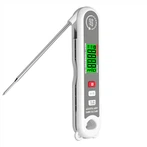Relationship between total magnification and resolution in oil immersion microscopy
The objectives of microscopes used in microbiological research are usually three types: low magnification (10x), high magnification (40x), and oil magnification (100x). There is also the word 'OI' (oil immersion) indicating that it has the highest magnification among the three. Depending on the magnification of the eyepiece used, the object being inspected can be magnified 1000-1600 times. When in use, the difference between an oil immersion lens and other objectives is that there is not a layer of air between the glass slide and the objective lens, but a layer of oil called an oil immersion system. This type of oil is often chosen as cedarwood oil because its refractive index n=1.52, which is the same as glass. When light passes through a glass slide, it can directly enter the objective lens through cedar oil without refraction. If the medium between the glass slide and the objective lens is air, it is called a dry system. When light passes through the glass slide, it is refracted and scattered, and the amount of light entering the objective lens is obviously reduced, which reduces the illumination of the field of view. The use of oil mirrors not only increases illumination, but also primarily increases numerical aperture, as the magnification efficiency of a microscope is determined by its numerical aperture. The so-called numerical aperture refers to the product of half the sine of the maximum angle at which light is projected onto the objective lens (known as the lens angle) multiplied by the refractive index of the medium between the glass slide and the objective lens. It can be expressed by the following formula: NA=n × sin а, where NA=numerical aperture; N=refractive index of the medium; A=half of the maximum incident angle, i.e. half of the angle of the mirror. Therefore, the greater the angle at which light is projected onto the objective lens, the greater the efficiency of the microscope, and the size of this angle depends on the diameter and focal length of the objective lens. Meanwhile, the theoretical limit of a is 90.. sin90.= Therefore, when using air as the medium (n=1), the numerical aperture cannot exceed 1. If using asphalt as the medium, as n increases, the numerical aperture also increases. If the incident angle of light is 120o and half of its sine is sin60o=0.87, then: when using air as the medium: NA=1 × 0.87=0.87; when using water as the medium: NA=1.33 × 0.87=1.15; when using asphalt as the medium: NA=1.52 × 0.87=1.32. The resolution of a microscope refers to its ability to distinguish the minimum distance between two points. It is directly proportional to the numerical aperture of the objective lens and inversely proportional to the wavelength length. Therefore, the larger the numerical aperture of the objective lens, the shorter the wavelength of the light wave, the greater the resolution of the microscope, and the clearer the fine structure of the object being inspected can be distinguished.
Therefore, the larger the numerical aperture of the objective lens, the shorter the wavelength of the light wave, the greater the resolution of the microscope, and the clearer the fine structure of the object being inspected can be distinguished. Therefore, a high resolution means a small distinguishable distance, and these two factors are inversely proportional. Some people usually describe resolution as how many micrometers or nanometers it is, which actually confuses resolution with the minimum resolution distance. The resolution of a microscope is represented by the minimum distance that can be resolved. The minimum distance that can distinguish between two points is λ/2NA, where λ=wavelength of the light wave. The average length of the light wave that can be perceived by the naked eye is 0.55 μ m. If the numerical aperture is 0.65 for a high-power objective lens, it can distinguish the distance between two points as 0.42 μ m. However, the distance between two points below 0.42 μ m cannot be distinguished, even if a larger magnification eyepiece is used to increase the overall magnification of the microscope. Only by using a larger objective lens with a larger numerical aperture can its resolution be increased. For example, when using an oil mirror with a numerical aperture of 1.25, the minimum distance between two points that can be distinguished is 0.55/(2 × 1.25)=0.22 μ m. Therefore, we can see that if a high-power objective lens with a magnification of 40 times (NA=0.65) and an eyepiece with a magnification of 24 times are used, although the total magnification is 960 times, the minimum resolution distance is only 0.42 μ m. If an oil mirror with a magnification of 90 times (NA=1.25) and an eyepiece with a magnification of 9 times are used, although the total magnification is 810 times, a distance of 0.22 μ m can be distinguished.






